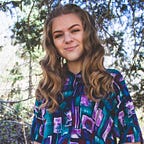True Crime: A Complete Experience
The project my team and I created over this past semester encompassed three main segments: an interactive kiosk, augmented reality, and a print element. Me and one other designer collaborated on this project with two students from the English department. We focused on the all the creation and design of the elements, while they wrote the copy.
Idea Formulation & Planning
I love the idea that we landed on, but that isn’t where we began. Initially, we bounced around ideas of creating a project centered around nature and wellness. While struggling to figure out how to combine the two topics in a natural and cohesive way, True Crime was brought up and we were all excited about it. While True Crime is very popular right now, that’s mostly the case in podcasts and TV. I haven’t seen a project like ours done about True Crime, so we ran with it. Each of the English students chose a true crime case to delve into and highlight, and that’s we focused on in the kiosk. I created the kiosk and print aspects.
Interactive Kiosk
The platform we chose to use for the interactive kiosk was Hype. It’s the one we were most experienced with and felt we could do the most with what we were trying to achieve. As a group, we decided that we wanted to create the sort of experience that made the user feel as it they were discovering and going through the criminal case files for themselves.
I took charge here and gathered all of the assets; this took quite a while, but thankfully I love the hunt of gathering assets! I was able to find some great ones on Adobe Stock, and created some of my own. What took even more time, though, was the Photoshopping. We had envisioned a particular look and feel for the project, and the majority of the assets didn’t quite fit that. So, I got very intimate with the quick selection and magnetic lasso tools, and did a bit of editing with color and texture for the assets. The screenshot below shows what the open file folder looked like to begin with. It wasn’t terrible, but just too bright and clean and happy.
Now, onto the actual kiosk. I set it up so it began in a dark detective’s office, with a box of files to tap on.
From there, the two case files (Dexter Copycat and The Unabomber) appear for the user to choose between.
Then, the template for each of the cases was the same. Once the folder is opened, the user is brought into an overview of the case. this page has a picture of the perpetrator, brief description, map, and then copy detailing the case. The user can tap on the photos for more photos, tap the map for an expansion of that, or simply tap “Next” to continue reading. I also included a little recording device that the user could press ‘play’ on to hear an audio recording and stop it as well.
The screenshots below show the photos page, and what it looks like when the user taps on the photo.
Then, there’s the map showing where the murderer lived, or where the murder took place.
I tried to maintain a dark, old, kind of grimy look throughout the kiosk. I also wanted the text to seem more like handwriting rather than a typed font.
My initial idea for the print aspect was to create WANTED posters; this seemed to fit the whole crime thing. However, when I started looking around for WANTED poster inspiration, nothing was fitting the aesthetic we were going for. Everything was just so… western. Too western and cheesy, like shown below. It wasn’t what I wanted, and I didn’t know how to turn it into something I wanted.
I then had the idea to instead create MISSING posters. I ended up liking this idea more anyway, because the kiosk portion was already focused on murderers and perpetrators. This segment was instead shedding some light on the victims and bringing attention to real missing people at the same time!
I went along with the old, textured paper feel I had used in the kiosk to bind the different segments together a little better. I choose four missing women, and began creating their posters. I was able to gather the information and descriptions pretty easily from the FBI. The missing persons posters that the FBI create (shown below) also did not fit our aesthetic. I just drew inspiration from it and began creating my own (also shown below).
I created a template in InDesign containing the police department, picture, name, age, date last seen, a description, call to action, and of course, the Zapcode in the bottom right corner.
Augmented Reality
This was a tough segment of the project. Neither of us designers had ever done anything with AR, so there was a lot to learn. In the end, it ended up being on the simpler side, but with the effort we applied, we were okay with that. Michelle took charge here, so I won’t detail the process.
Wrap-Up
Final Print:
You can use the Zapworks app to scan the Zapcode and view the AR component.
Demo video:
https://www.youtube.com/watch?v=7Nm-9HNxOB0&feature=youtu.be
I had quite a bit of fun with this project. I was able to find a real passion and excitement for it, and I wanted to produce a truly great product. The COVID-19 situation did throw us for quite a bit of a loop. It made collaborating on the projects far more difficult, and because of that I don’t think we were able to do as much as we were hoping. Overall, I am very happy with the outcome and believe this will make a great portfolio piece!
